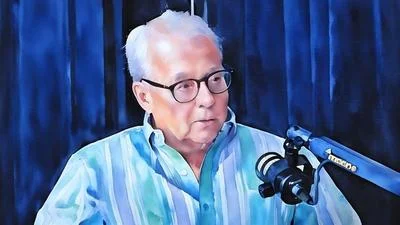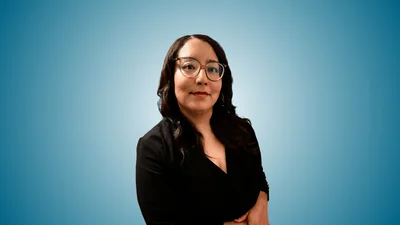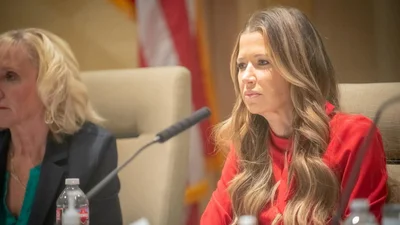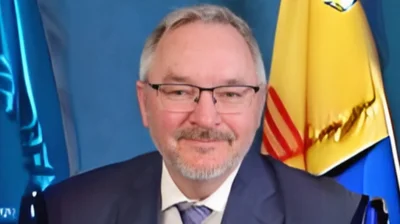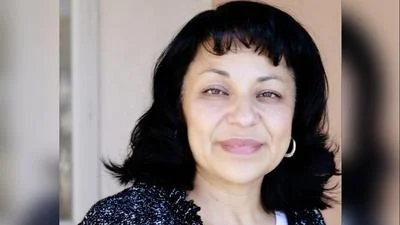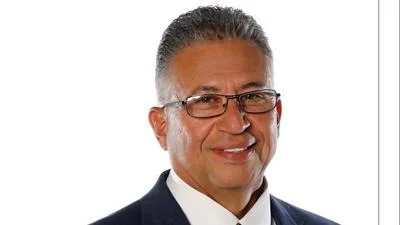City of Santa Fe Planning Commission met June 3.
Here are the minutes provided by the commission:
CALL TO ORDER
A regular meeting of the City of Santa Fe Planning Commission was called to order by Chair Gutierrez on the above date at approximately 6:00 p.m. at a virtual meeting.
A. ROLL CALL
Roll Call indicated the presence of a quorum for the meeting.
Members Present
Commissioner Brian Patrick Gutierrez, Chair
Commissioner Mark Hogan, Vice Chair
Commissioner Janet Clow, Secretary
Commissioner Amanda Chavez
Commissioner Pilar Faulkner
Commissioner Lee Garcia - Arrived at 6:05 pm
Commissioner Carly Piccarello
Commissioner Dominic Sategna - Arrived at 6:10 pm
Members Absent
Commissioner Jessica Lawrence (Excused)
Others Present:
Mr. Elias Isaacson, Land Use Director
Mr. Noah Berke, Planning Manager
Ms. Sally Paez, Assistant City Attorney
Ms. Melissa D. Byers, Stenographer
NOTE: All items in the Committee packet for all agenda items are incorporated herewith by reference. The original Committee packet is on file in the Land Use Department.
B. PLEDGE OF ALLEGIANCE
Commissioner Hogan led the pledge of allegiance.
C. APPROVAL OF AGENDA
MOTION: Commissioner Faulkner moved, seconded by Commissioner Hogan to
approve the agenda, as presented.
VOTE:
The motion passed by unanimous roll call vote with Commissioners Chavez, Clow, Faulkner, Hogan, and Piccarello voting in favor and none voting against.
D. APPROVAL OF MINUTES
1. May 6, 2021
MOTION:
Commissioner Faulkner moved, seconded by Commissioner Hogan to approve the minutes of May 6, 2021 as presented.
VOTE:
The motion passed by unanimous roll call vote with Commissioners Chavez, Clow, Faulkner, Hogan, Piccarello and voting in favor and none voting against.
APPROVAL OF FINDINGS/CONCLUSIONS
None
OLD BUSINESS
None
NEW BUSINESS
None
STAFF COMMUNICATIONS
1. Informational Presentation: Metropolitan Planning Organization (Erick Aune MPO).
Eric Aune from MPO presented a PowerPoint presentation. He explained the MPO is representative of the City and County of Santa Fe, Pueblo of Tesuque and the New Mexico Department of Transportation (NMDOT). It is an independent government organization made by a Memorandum of Understanding and agreement and is hosted by the City. He introduced the other members on the MPO team.
He said a core tool of the MPO is the Metropolitan Transportation Plan. They are obligated at the federal level to update the plan every five years. The plan contains information about the operation of the entire system of transit, bicycles, pedestrians, and traffic. The plan produces a list of projects for the improvement of roadways and multi use trails. Those include roadway, intersection and safety improvements.
The Bicycle Master Plan, the Trail Plan and the Pedestrian Master Plan are used to inform the city based on safety, and there is also a Public Transit Master Plan.
An overview of history starting with the railroad in the 1800s was reviewed. In 1912 a City Plan was put in place looking at the future planning for improvement of streets, and wastewater. Paved roads started in the 30's and in 1935 the MUTCD (Manual on Uniform Traffic Control Devices) was created. The Manual is the national guideline with a challenge that it is skewed for the automobile. In 1947 the City adopted zoning standards for roadways, resulting in things such as the traffic light at Old Santa Fe Trail and San Francisco in 1956.
Today they are rethinking what is appropriate, such as what St. Michael's should look like. The Pedestrian Safety Study that came out this week shows Santa Fe City and County second behind Albuquerque in pedestrian crashes, deaths and injuries. Mr. Aune felt there is a direct correlation in the amount of free parking and traffic congestion. He thought it a good idea to look at the code and what it delivers. He provided an example of a new sidewalk on Aqua Fria not compliant with Code. The sidewalk is built up against the wall on a curve, eliminating accessibility for someone in a wheelchair. It is also, the 5 foot bare minimum width making it difficult for two people to walk side by side. Many of the sidewalks in Santa Fe share space with bicycles, and he hears a lot of complaints about too many bicycles on sidewalks.
Code states that pedestrian crosswalks must be included as required by the land use director. The MPO notes a lack of crosswalks throughout the City which was a conscious choice and believes they are essential to pedestrian safety. The City currently has a multimodal study that can be taken online to aid the city and looking at the challenge of systemic programmatic policies that are automobile dominated.
The MPO developed an interactive Bicycle Master Plan project for planners as well as individuals, to inform them of projects under consideration. It gives the existing multi modal bicycle network.
Mr. Aune stood for questions.
Director Isaacson asked Mr. Aune about MPO's involvement in the Arroyo Chamiso crossing project and if he had any new information.
Mr. Aune replied MPO provides a travel demand model looking at existing and proposed land uses. MPO does an algorithm calculation on what those uses would deliver in terms of traffic etc, and has provided that to the City for their analysis of the Arroyo Chamiso crossing (a.k.a. Richards Road extension) which was shut down in 2010 because the neighborhood was against it, it was revived four years ago and is moving forward with phase B design.
Commissioner Garcia said the challenge is taking a 500 year old City and making it modern. He said when he looks at the new development sidewalk, he would ask why it was built that way and how it passed inspection. They will see a lot of that until the City takes up the challenge to do sidewalks and infrastructure.
Vice Chair Hogan asked if there was a plan to connect Richards Avenue to 599 at some point.
Mr. Aune replied that has been discussed in the long term plan. However, it would be very expensive and is not a priority project, but it is being considered.
Vice Chair Hogan said the development of the Bike and Trail Masterplan citywide is very impressive and has alternative ways of getting around Santa Fe instead of using a car. He asked about the critical connections that need to be made.
Mr. Aune said he was happy that the City and County take this seriously. The underpass at St. Michael's comes up a lot. He is aware there are concerns about the homeless and safety. There was a safety audit and federal safety plans, and the City has hired a consultant who should wrap up a design within a year. The City is trying to determine the final connection for another connector, the Santa Fe River Trail, through the Agua Fria/South Meadows to the River Trail at San Felipe. Also, the Acequia Trail has been funded. So, in the next couple of years the south side should see tremendous improvements for connectivity. The MPO supports that for recreation and a safe, alternative way to get to work. There are many needs and gaps in the connections with the Bicycle Master Plan that the MPO will strive to achieve in collaboration with the City and County.
Vice Chair Hogan asked if there is opportunity for input on the infrastructure funding from the federal government.
Mr. Aune said the State of New Mexico passed an infrastructure project fund in the amount of $121 million dollars. It is expected that the MPO area including the Pueblo of Tesuque, will get about $5 million of that. MPO has been working with Public Works and City and County on eligible projects for those funds. In addition to the federal funds. the City/County has committed to using road and gas tax to commit $40 million a year to the fund. The latest version in the Senate includes an additional billion dollars for bicycles and pedestrians, so he is watching to see if that survives.
Commissioner Sategna and Commissioner Garcia indicated their arrival times for the record.
Chair Garcia asked which is first, the MPO or the future land use map.
Mr. Aune explained when MPO updates their travel demand model every six years or so, they coordinate long term plans with City and County Land Use staff. That information includes upcoming projects to inform the design. There was a public meeting on St. Francis and St. Michael's about two weeks ago on the design. DOT also has a team redesigning Cerrillos Road from St. Michael's to St. Francis. He thought that compelling because they are thinking critically about what the design will deliver because the City will take over Cerrillos and St. Michael's.
Commissioner Garcia asked if the West Alameda area is being considered.
Mr. Aune said three county commissioners are on the policy board and three City councilors are working together. As a result of the annexation there is collaboration with West Alameda on drainage improvements and a roundabout.
Commissioner Garcia asked if any trail connections are considered for pedestrians or bicycles.
Mr. Aune said yes, Commissioner Anna Hansen is a big advocate for that area.
Commissioner Sategna asked for more information on the lack of pedestrian lanes.
Mr. Aune said there are two substantive issues: the width of the sidewalks and crosswalks. He wanted to include MUTCD (Manual on Uniform Traffic Control Devices) in the presentation because he learned there were no crosswalks or sidewalks at Capital High School. The City uses MUTCD, but their standards are rational from an engineering perspective only. They are illogical from a planning perspective and should be looked at critically and only as guidelines. The communities that were effective in changing the pedestrian and bicycle safety have top down leadership. They empower engineers to change their behavior. He felt there were many reasons to question just following the guidelines and continuing the same practice.
Commissioner Sategna asked if he had seen any approach as very successful in increasing pedestrian safety and crosswalks, bike paths etc.
Mr. Aune said yes, when the leadership across the nation from people such as the Planning Commission, City Council, etc. say, we can do better, and look at the best management practices across the nation. He appreciates the roundabouts, and the good work Santa Fe has done in that area and hopes that continues.
Chair Gutierrez asked with all of the building in South Meadows if the traffic issues, etc. will be left to the City to resolve or will the MPO get involved.
Mr. Aune said the MPO supports the City and is putting a lot of energy in their partners such as the schools and national parks system. MPO wants to raise awareness that 1) it is the fastest growing parts of the City, 2) you can see it and 3) it is willfully deficient. This morning the MPO started a public engagement campaign with the help of City Councilors. They placed 35 large details on sidewalks and bus stops throughout the South Meadows area asking for input. A queue code can be scanned on your phone that takes you to the survey on the website. They plan a walking audit with the community on August 24th to look at the sidewalks and raise awareness of improvements happening and what could be done better.
Commissioner Piccarello said we are seeing significant changes from other cities regarding climate change. She asked if he could choose one thing, what would the MPO want the City to become more aggressive in with their planning.
Mr. Aune replied the number one thing from a planning perspective is that the City has overbuilt the roadways. The City should not only stop overbuilding, but stop the road diets on St. Michael's. Siler Road is an example and used to be four lanes and has been reduced and there is road reduction on Guadalupe north. The City needs to reverse the incentive to drive and provide alternative transit. Secondly is a quasi-public/private partnership for electric charging stations for automobiles and there has to be an increase in renewable energy.
Commissioner Sategna asked if there was a way to build on the existing bike paths to promote biking and walkable spaces. They appear to be underused and undervalued as a way to create walk ability or less reliance on a car.
Mr. Aune responded that leveraging that goes back to specific things the City could do to incentivize people. Free parking is one example that incentivizes people to drive. He recently received a call from a new museum with concerns about little or no additional parking. He looks at that as an incentive for people to walk. It is a market mentality and a matter of getting people out to walk, bike and not to drive. He would like to see incentives for people to bike to work. The MPO is working with the City on their five year transit plan now and that is what he recommends.
Commissioner Faulkner said her concern is that the Santa Fe bus system is not that great. She thought the City would not be successful in removing parking spaces until there is a more effective transit system.
Mr. Aune said the people at Transit recognize that. Most of their funds are federally provided, and the City matches with GRT funds. Increasing frequency and effectiveness of transit will cost extra. The question is if the City is interested in spending extra money, otherwise it can't be done. He agreed it should be looked at as a system and not just parking or transit
He said his challenge is the Traffic Impact Assessments (TIA) used by the Planning Commission when making decisions. A TIA has an inherent bias for suburban development and assumptions built from suburban development. They are biased to deliver bigger wider roads in the suburban sprawl. He would like TIAs to be transportation impact assessments with pedestrians on equal footing in the analysis. Raising awareness could possibly change that.
Commissioner Faulkner said she appreciated his insight from an engineering versus planning approach. She felt engineering doesn't always consider community and how they work, or do not work and those two things could be in conflict at times.
Commissioner Piccarello said she is a one car family and lives in an area where there is a bike path. Not every area of the city has that. She asked what areas most lack bike accessibility.
Mr. Aune said MPO is looking at development patterns from the County where there is no accommodation for anything other than a road and car. The southside sector and peripheral areas of Santa Fe are areas of greatest example, such as Rodeo Road The bridge is frightening and doesn't have much room to walk. Zoning and land use around the bridge includes many multifamily and senior developments and residential and the roadway is lacking in sidewalks, bike facilities and almost everything.
Commissioner Piccarello recalled a town in the northeast that made the bus system free and were looking at how that would impact their employment rate. They were only going to do that for a year. The point is to look at the bus system and unemployment rate together. She wondered if there is room for the City to do that.
Mr. Aune said yes, but there are two sides of the coin. Leadership often thinks if they have more transit then more people would ride it. The component cohort that services want to attract is people working and commuting as a means of getting out of the car. Not because they don't have a car or because of financial reasons. The flip side of the coin is if a city isn't willing to add frequency and investmen "free" devalues the system and it doesn't work.
Chair Gutierrez thanked Mr. Aune for the presentation.
2. Planning for Growth. (Elias Isaacson)
Director Isaacson gave a presentation on Planning for Growth. He said the issues Mr. Aune presented tonight dovetail with the growth planning issues. He said historically Santa Fe had been dealing with growth management issues since inception.
Growth management planning is a type of comprehensive plan used to measure the impact of new growth impact on a community and helps to define the policies and regulations by which that impact will be managed. It recognizes that managing growth will enhance quality of life, identify locations for various land uses for future growth, and determine proper scale and density for future land uses. Establishing appropriate pace of future growth is required to sustain that growth and developing around existing new urban centers with access to trails and transit services to reduce automobile dependence and promote pedestrians. The promotion of development also provides a range of housing options that address the needs of the community affordably.
The current general plan establishes a framework for responding to the challenges and opportunities presented by our city's growth. A growth management plan should be organized to respond to the community's specific vision and goals and objectives.
Looking at the growth management in Chapter 4 of the General plan, there are things like quality of life, urban form, transportation alternatives, water, sustainable growth, and regional perspective for planning. There is the creation of themes for livability, housing affordability, and equity in the safety and wellness and economic health of a community. Design issues like density, connectivity, architecture, urban design, infrastructure, transportation and environmental quality, all involve regional planning.
It addresses questions on climate change and carbon emissions, the amount of open space, landscape and opportunities for local food production. Growth management planning is important because Santa Fe is unique and a remarkable place to live and it continues to attract people. The challenge, as people relocate to Santa Fe, is to create a smart and inclusive growth plan that ensures growth, provides equitable access to future employment, housing choice affordability and the City's cultural and natural resources.
Most of the City's population growth can be attributed to the several phases of annexation. They are now beginning to see accelerated migration facilitated by what is referred to as the “zoom boom". The average household size is dropping, and the City is getting older, and families are no longer moving in. The census tracts in 2010 versus 2020 show populations over the age of 65. The question becomes what that means for local housing. Median house values are steadily rising but households are not. As that gap continues, finding acceptable housing options are more challenging. Owner occupied housing went up in 2020 but the vacancy rate has remained flat.
With the growth management planning, the public engagement process will be open and designed to challenge the thinking about the future. It will be inclusive and should be guided by goals to educate, engage and empower the community. Effort should be made to include new voices in the process and outreach. An entire generation of people in Santa Fe have not had an opportunity to engage in shaping the vision and future of the City. A number of things have been done to address growth such as the annexation of land in the southern part of the City, zoning overlays like the Midtown Link, the redevelopment of the Midtown Campus and the planning efforts in the southwest area and the 25 Year Sustainable Santa Fe plan. Also, recently, the Santa Fe River Corridor Plan.
The City has limited development in some areas and added a green building ordinance; adopted HERS, an energy and water efficiency rating system. Santa Fe has an active water planning and conservation team working on 40-80 year plans, and has looked at storm water management to protect arroyos and how to plan infrastructure expansion. The Land Use Department identified appropriate rates and impact fees and will look at growth infill and the benefits of density. A big goal will be creating policies that support walkable neighborhoods and a sense of community that provides for active lifestyles, with easy access to parks, trails and open space.
Density ranges from 21 to 29 units per acre. It is important to incentivize multimodal travel and reduce reliance on automobiles which plays a big part in housing affordability. That also helps the City reach its goals on carbon neutrality. The Mayor and City Council are looking at opportunities to make fees permanent for funding the Affordable Housing Trust Fund. Street networks should be balanced by reliable, efficient public transportation systems. The City cannot build out of their traffic problems, so focus is also on resource conservation. The City is collaborating with the Santa Fe County Utilities Department and initiated a community informed planning study to develop a long-range Water Resource Management study. The current study will be completed by 2024 and continue to be reevaluated and repeated, as necessary. The plans extend as far out as 2100.
From a regional growth management perspective, the 1999 General Plan identified the importance of regional planning to manage growth. The next steps are working on an RFP which will take them through the summer of this year which includes a scope of work. After the RFP they will evaluate and probably start the planning process in the winter of 2022.
Director Isaacson stood for questions.
Chair Gutierrez's explained the presentation was not on the agenda, however, it was a last minute decision that it would be heard.
He noted his batteries were running low and asked Vice Chair Hogan to take over for a moment.
Commissioner Chavez said everyone likes to be part of community engagement, but doing that equitably and getting good representation of the community is more difficult. She asked what steps are planned to engage the community.
Director Isaacson said they haven't actually discussed that much. They will ask those who respond to the RFP to provide ideas on how to engage the community. He said we want their strategy and tools for getting that information. He was on the selection committee for the multimodal transit study. They discussed the importance of the selection process, and the strategies the different teams recommend. Then they will evaluate and discuss what would be the most successful.
Commissioner Chavez explained she is a big community advocate and knows how difficult community engagement can be. Proposals to engage are great but the question is whether the community is really engaged, and their voice is represented. It is one thing to propose a plan for engagement but another to actually hold individuals, or a consulting group, accountable.
Director Isaacson agreed. The community engagement process will last for months so is not comparable to an ENN. This process will focus on asking the community their vision and values and what are the trade-offs. That will be built into the proposal process.
Commissioner Faulkner said she was concerned that when reaching out to consultants, many are from out of state. They often don't have a clear perspective of the community or the values. She wanted to be sure to capture the culture and the big picture of Santa Fe. She noted a number of nonprofits serve Santa Feans that could be consulted. She wondered if they have been considered, or if that was required of consultants in the RFP.
Director Isaacson said it is not in the RFP. He thought consultants would have the same thought about contacting partners. There are also other departments, such as Arts and Culture or a division that is a part of the community development group that he would like to be involved in outreach.
Commissioner Sategna said for the record, he wanted to know why they are not pursuing a general plan and focus is only on the growth management plan. He asked what the differences are in those and why the Land Use Department is promoting a growth development plan versus a general plan update.
Director Isaacson said the 1999 General Plan is an important starting point for additional long-range planning and they will build off that. The current challenges are the issues related to the City's growth. Those can be addressed through growth management and long-range planning more quickly. That also provides the foundation for future long range planning, whether a full general plan update or a pivot to a small area or other type of climate effort plan. That by no means forecloses on future updates to the general plan, but is the most effective to the challenges of housing affordability, sustainability, transit, infrastructure planning, etc.
Commissioner Sategna said to follow up on that he wanted to know what Director Isaacson felt was being excluded. He wasn't clear about the differences and understands that growth management is part of the general plan. Focusing only on growth management, he asked what will be excluded.
Director Isaacson's response was that he wouldn't say that something was being excluded, he would say things were being prioritized. This looks more at the relationships between the topics instead of each topic individually. This is an opportunity to find synergies through that lens rather than just updating sections of the general plan. He found those to be a more siloed approach that is indicative of long-range planning in the 1990s and early 2000's.
Commissioner Chavez asked to follow up on Commissioner Sategna's comments. She said she understood what Director Isaacson was saying. She thought, however, he would be running into roadblocks. She asked if he didn't feel he was going to run into barriers with a focus on just one part of the general plan. She thought what made an effective general plan is that there are systems that work together in a common direction. She asked if they chuck that, how would that not interfere with the systems working properly.
Director Isaacson thought the growth management plan was more systems focused than a traditional general plan. It looks at the relationships of transportation, infrastructure, open space, water conservation, etc. A growth management plan is as much of a comprehensive plan as a general plan, but is about what is working and not working. Outcomes are about recommendations for land use policy. The focus is what are the impacts of growth and what is most appropriate so growth can happen in a sustainable, fiscally responsible way. He thought this approach no less comprehensive or less system focused than the general planning effort in 1999. In fact, it is more so because of advancements around moderate planning.
Commissioner Chavez asked if the growth management plan and general plan will work together rather than the focus being on growth management because it has been evolved.
Director Isaacson said the two plans wouldn't necessarily be worked on side-by side, but more in an integrated fashion. The growth management plan will provide more concise, prescriptive recommendations on managing growth. It is designed to work in concert. If in the future a more robust update of the general plan is required, that could be done at that time.
He said the importance of the commitment to update any long-range plan came up in the Quality of Life meeting. The design can almost be for an update at 5-10 year intervals to ensure the recommendations and policies still work.
Commissioner Faulkner asked if safe to say that the general plan approach is antiquated, and growth management is a new form of a general plan.
Director Isaacson said obviously some communities still do general plans and there are reasons why. Some communities consistently update their plan, and the plan continues to make sense. He said we find we have deferred maintenance in our long-range plan. We have taken a more thematic based approach to innovation to allow Santa Fe to respond and develop ideas and strategies for some of the challenges.
Director Isaacson said he wasn't saying that the general plan doesn't have a purpose or lacks importance. By examining land-use policies through a growth management plan they can revisit the general plan. That does the heavy lifting.
Commissioner Faulkner thought the approach of looking at the lens of growth management would accomplish a lot of things. A lot of would be updating the general plan which would be related to the growth of Santa Fe from a town to a city.
Director Isaacson agreed. He said updating the general plan, most likely would be talking about growth anyway. They should just go ahead and focus on growth management as the first pass through the general plan, or a longer planning document. Then they could move on to address other aspects.
Commissioner Sategna said this is all new information and he appreciated the presentation. He knew the Mayor and City Council supported this. His concern was the level of public engagement in a process where they are honing in, and focusing on one aspect. He thought historically a general plan update requires all members of the community be engaged in the process. He was looking forward to seeing how that would happen. He asked if there is a requirement to update the general plan, and if so, when that would be done since the focus is only on one aspect of the general plan.
Director Isaacson indicated that both the general plan and growth management process of engaging the public are similar. They should not be concerned that the public would be engaged differently. The growth management process covers many of the same questions and topics on the vision and values, the direction the City wants to go, and what are the trade-offs. He asked if Attorney Paez wanted to comment on the legal obligation for a general plan update.
Attorney Paez explained the City is required to have a comprehensive plan but there is no timeframe required for updates. In terms of state law, the City's authority for land-use regulation and the Commission's authority is important that a plan be in place. The statutes call it a master plan and a comprehensive plan, and a general plan serves as the legal function. She thought possibly these things could be incorporated as an amendment, or they could update portions. Ultimately it needs to be a guiding document,
There were no further questions from Commissioners.
Chair Gutierrez asked if there were other staff communications.
Mr. Berke reported there would be no second meeting in June, and they will continue to meet virtually. He anticipated the Attorney General will make a decision once the public health emergency is lifted, on how public meetings should be conducted. He indicated a hybrid model will be tested in the chambers with the Governing Body and he will have more information.
Director Isaacson said to add to that, City Councilors will meet June 9th in a hybrid meeting in Council Chambers, but everyone else including staff, will be virtual. The City will evaluate the effectiveness of that and decide for commissions and other committees in July. He thought possibly the Commission would meet in person the first or second meeting in July in chambers, but staff and the public would still log in.
Director Isaacson said the important thing to note is that once they switch to an in person format, all of the Commissioners will have to be present.
I. MATTERS FROM THE COMMISSION
• Policy Subcommittee Update.
Commissioner Faulkner reported on the Subcommittee work. They spent the first several meetings on administrative matters and the process for review and assessment and recommendations. Two soft policies have been identified, one serving as advisors to the Land Use staff on the RFP for the growth management plan and the hygiene scrub of Chapter 14 if staff wants the help. Also, two major priorities will be the cannabis policy and an affordable housing policy specifically addressing Chapter 14 that could be used to encourage or enhance affordable housing build out. Their first policy meeting is on June 10th with the purpose of being educated on their priorities. Staff has consented to doing presentations and she also invited City Councilors to participate.
Commissioner Faulkner offered to email the full process document to those interested.
ADJOURNMENT
Chair Gutierrez adjourned the meeting at 7:55 pm.
https://santafe.primegov.com/public/portal
